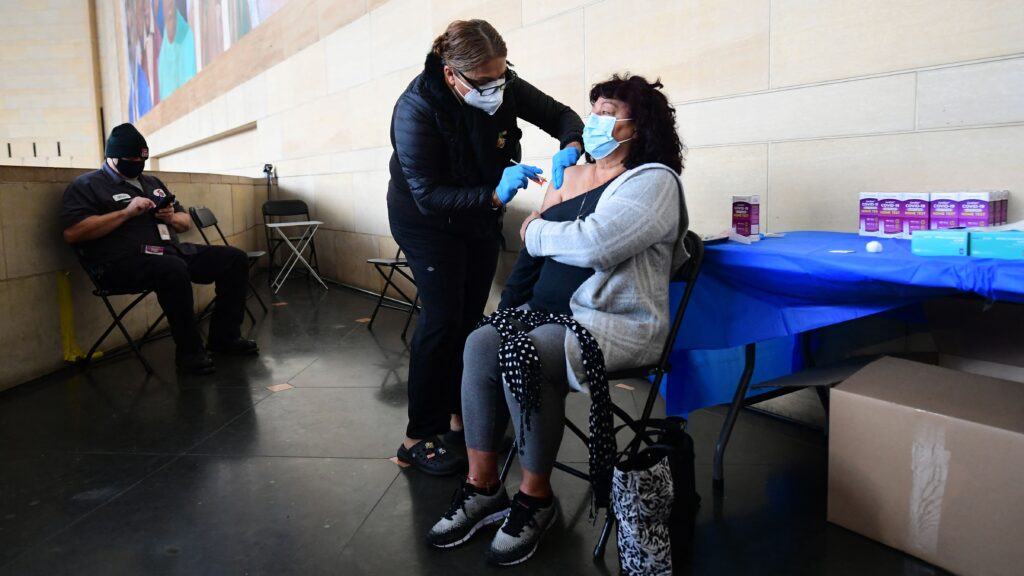The number of children who received their routine vaccinations declined during the pandemic, so public health officials have been focusing on getting kids back up to date. They should also be paying attention to adults as a new, first-of-its-kind report quantifying the economic impact of adult immunizations makes clear.
Researchers at the nonprofit Office of Health Economics, based in London, analyzed four adult vaccine programs — for the flu, pneumonia, respiratory syncytial virus (RSV), and shingles — across 10 countries including Australia, France, Japan, and the United States. They found that adult vaccination programs paid for themselves many times over, returning up to 19 times the initial investment in societal benefits.
Vaccines are among the most effective public health inventions in human history. Yet despite the clear benefits, the most recent data from The Commonwealth Fund indicates that the 2021 flu vaccination rate for U.S. adults was just 42%. By contrast, in the 2022-2023 school year, 93% of kindergartners received all state-required vaccines.
This shows what a difference a concerted policy effort can make: providers administer childhood vaccines based on a schedule set by the U.S. Centers for Disease Control and Prevention’s Advisory Committee on Immunization Practices. The schedule for adult vaccines is much more complex.
I know the public health community can do better. During the pandemic, nearly 80% of U.S. adults completed their primary series of Covid-19 shots.
With that public health emergency in the rearview mirror, the U.S. has slipped into complacency, and demand for vaccines across the life course is falling. Fewer than half of adults received updated Covid-19 and flu shots last year. New vaccines offer adults protection against RSV and shingles, but most Americans eligible for these shots aren’t getting them: Nearly two in three people age 65 and older haven’t received the shingles vaccine, which the CDC recommends that people aged 50 and older get. Only 23% of people 65 and older have gotten the RSV shot, which is encouraged for every adult aged 60 and over.
Severe cases of flu, pneumonia, RSV, and even shingles can be deadly. Vaccines can prevent many of these deaths. A study by the Brown School of Public Health found that if Covid-19 vaccinations had stayed at their peak rate, the United States could have averted more than 300,000 deaths between January 2021 and April 2022.
Vaccines also offer protection against conditions beyond the ones for which they’re designed, because they reduce the risk of other health issues like heart attacks and certain cancers. A study cited in the Office of Health Economics report found that getting a flu shot can lower the risk of stroke and subsequent hospitalization among elderly people by as much as 16%.
As the U.S. population ages, the importance of boosting adult vaccination rates will only grow. Without a campaign to increase adult vaccination, experts estimate that rates of vaccine-preventable illnesses will rise over the next 30 years. That won’t just lead to more human suffering. It will also impose staggering costs on major world economies.
How can the U.S. increase vaccination rates for adults? The process begins with encouraging doctors, biopharmaceutical companies, and government leaders to work together to build awareness of recommended vaccines and their impact and remove barriers to access. Studies show that when physicians and community leaders recommend vaccination, it has a positive impact on increasing rates.
During the pandemic, a focus on community-based organizing helped ensure that vaccination rates for Covid-19 were high. The CDC’s Covid-19 Vaccine Equity Community Education and Outreach Initiative, for example, provided federal funding to trusted community organizations during the pandemic. The outreach conducted by these organizations helped increase vaccine uptake in communities disproportionately impacted by the pandemic. It’s why one of the policy priorities of BIO, the organization I work for, is to continue the CDC-funded, community-based outreach approach and transition the focus to routine vaccinations.
Every American, regardless of their insurance status, should have equitable access to all recommended vaccines with no out-of-pocket costs.
The federal government can guarantee that uninsured adults have access to routine vaccines with zero cost sharing, just like insured patients. And when insured patients try to get vaccinated, they shouldn’t run into surprise charges from their insurance company. High vaccine coverage in adults would more than pay for itself by preventing healthy adults from getting sick and incurring taxpayer-funded healthcare expenses in the future.
Lawmakers at every level of government should also ensure that different types of medical providers — including physician assistants and pharmacists — can administer vaccines to adults, no matter what state they work in. Some states still impose restrictions on the ability of non-physician providers to administer vaccines, despite a lack of evidence that more relaxed policies pose any health risk to patients. This measure would prove especially valuable for underserved communities.
The public health community knows what works and knows how to get things done. Investing in life-course immunization will pay for itself in health and prosperity.
Phyllis Arthur is the senior vice president of infectious disease and emerging science policy at the Biotechnology Innovation Organization (BIO).
